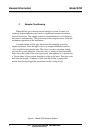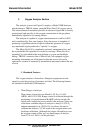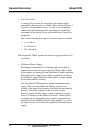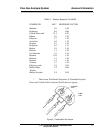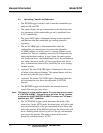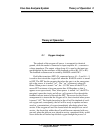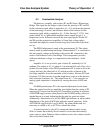
10
General Information Model 9700
TELEDYNE BROWN ENGINEERING
Analytical Instruments
The sample is sent through one side (SAMP) of twin indicating
flowmeters. Since it is necessary that there is sufficient oxygen in the
sample being analyzed to insure full combustion of any combustible gases
present, the sample is blended, or diluted, with an equal amount of “clean”
compressed air. The compressed air is introduced through the second
(AIR) of the two flowmeters. Two flowmeters are used so that an equal
volume of both sample and air flow can be visually set.
The flowmeters, valves, sensor and associated plumbing are installed
within a temperature controlled box. Temperature is held at about 130 deg
F to keep all components above the dew point of the sample gas.
The sample stream is routed past the combustible gas sensing element.
This element is a low-temperature, catalytic bead type transducer in a
constant current-excited Wheatstone Bridge circuit. Two legs of the bridge
are exposed to the sample gas. The other two legs are passive elements in
the control unit. Gas diffuses into the sensing element and oxidizes at the
catalytic surface of the active or measuring bead, causing its temperature to
rise. The reference bead is not catalytically coated and, consequently, is not
heated by the combustibles. The difference in resistance of the otherwise
matched pair of catalytic beads creates a signal in the bridge circuit. Use of
the uncoated reference bead compensates for the effects of temperature
variations, humidity changes, ambient pressure changes and variations in
line resistance. The signal from the bridge is amplified and displayed on a
meter with a 0–5% combustible range. A diagrammatic illustration of the
combustible sensor is shown in Figure 5.
The beads are installed in a housing which has a flashback arrestor
screen at the sensing aperture to prevent flame propagation back into the
process.
Response of a catalytic bead sensor to a number of gases is shown in
Table I.
An adjustable alarm can be set at any value within the full range. The
latching or non-latching alarm relay can be wired to auxiliary lights, horns,
fans, or used for equipment shutdown.
At completion of combustibles analysis, the sample stream is vented
from the analysis circuit.



